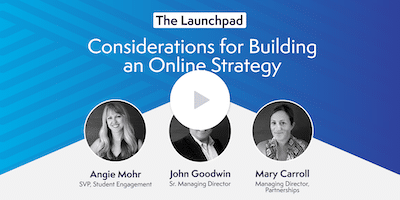The Impact of AI on Higher Education Content Marketing Tactics
By the time you read this, it could be old news — that’s how fast the field of artificial intelligence (AI) is evolving. While the full impact of AI on the economy and various industries is unknowable, a transformation is happening, and higher education content marketers are already feeling the effects.
Before we explore how AI is transforming higher ed marketing, though, let’s take stock of recent developments in the field.
What Just Happened? Understanding Recent AI Developments
If you haven’t yet explored ChatGPT or another generative AI model, you may be wondering what the sudden hoopla (obsession?) surrounding the technology is all about. While AI isn’t new, the landscape shifted dramatically when OpenAI launched ChatGPT in November 2022.
For most people, ChatGPT was their introduction to large language model (LLM) AI, a technological advancement distinguished by several key features.
- Scale: LLMs are massive. They draw from huge datasets and have billions of parameters, enabling them to provide more nuanced and accurate answers to queries.
- Versatility: The capabilities of LLMs extend far beyond conversation. They can summarize text, generate code, draft documents, and assist with countless other tasks.
- Contextual Understanding: Compared to their simpler chatbot predecessors, LLMs have a far more sophisticated grasp of context. This improves the accuracy and relevancy of their responses significantly.
- Humanlike Interactions: Although it’s hard to pin down the most critical aspect of LLMs, their ability to generate humanlike responses is undeniably a significant factor that has captured the public’s imagination and interest.
These advanced features fundamentally alter how we can interact with machines and access information. ChatGPT isn’t the only game in town, but its debut was a big deal. For many people, it felt like a switch was flipped — and, in practical terms, it was.
Using AI in Higher Ed Content Creation
The ability of LLMs to generate text that closely mimics human writing has obvious significance for anyone involved in creating content. It’s not surprising then that LLMs had an immediate effect on the way some marketing content is being created in the higher ed industry.
Perhaps most notably, LLM AI was promptly (no pun intended) put to use by some institutions in the creation of blogs, program page content, and other marketing materials. The technology can generate drafts quickly and at scale, and it excels at tasks like keyword integration and metadata creation.
To be clear, current AI technology isn’t a magic bullet — more on that later — but it can help writers, editors, and other marketing professionals achieve significant productivity gains, which is why many have been quick to adopt ChatGPT, Claude, DALL-E, Copy.ai, Google Bard, Jasper, and other tools for text and image creation.
Using AI in Other Areas of Higher Ed Marketing
Using AI to produce content is just one marketing use case among many. When you consider how the strengths of LLMs align with the work of higher ed marketers, the potential for transformation multiplies.
- Automation: LLM AI enhances automation by bringing in advanced data analytics, contextual understanding, and greater adaptability. Such improvements should give higher education marketers more insight into areas like student enrollment and course popularity.
- Natural Language Processing: When they are fed by the vast datasets of LLMs, natural language processing (NLP) algorithms can interpret and respond to human language much more effectively. Such capabilities promise to make chatbots more accurate and personalized when answering questions about financial aid, course selection, or application procedures.
- Data Analysis: LLM AI holds promise for elevating data analytics in higher education marketing by offering nuanced insights into student enrollment and course popularity. Additionally, these tools are changing search engine optimization (SEO) by automating the analysis of search trends and competitor strategies.
The productivity gains offered by LLM AI in automation, NLP, and data analysis should free up marketing teams to focus on higher-level creative and strategic tasks. It sounds simple enough; however, while AI technology is advancing at a blistering pace, the gap between emerging technologies and fully developed solutions remains significant. During this nascent stage, when content marketers are still figuring out how best to integrate AI into their work, it’s helpful to review core values and establish best practices.
Avoiding Pitfalls and Creating Preferred Practices
To successfully integrate AI into your marketing strategy, here are some potential pitfalls to avoid and preferred practices to adopt.
Ignoring the Inevitable vs. Embracing a Hybrid Model
Resistance is a natural response to change, but ignoring AI won’t help your organization. By disregarding the inevitable integration of AI into various areas of marketing, institutions risk missing out on critical insights, efficiencies, and engagement opportunities.
AI is a tool, and it should be used to enhance human labor, not replace it. By embracing a hybrid model, institutions can harness the computational power of AI while also capitalizing on the unique human qualities of creativity, empathy, critical thinking, and intuition.
Thinking AI Is a Magic Bullet (or Just Magical) vs. Cultivating an Aggressive Test-and-Learn Environment
It’s easy to be dazzled by the capabilities of advanced AI tools, but thinking AI is the answer to every challenge is a recipe for rash decisions and costly missteps. (And if you find yourself wondering why ChatGPT doesn’t know your dog’s name, it might be time for a personal reset.)
Organizational urgency around adopting AI should be focused on learning, not decision-making. This approach allows organizations to quickly discover and share best practices and maximize the potential of AI while preserving the practices that deliver unique value.
“Winging It” vs. Establishing Organizational Guidelines for AI Use
When is it appropriate to use AI-driven data analytics instead of traditional market research methods? Under what circumstances should chatbot interactions transition to human representatives? When AI is used to generate content or inform a strategy, what’s the most effective way to disclose that information to partners and others?
Setting organizational guidelines for AI use is imperative because it streamlines operations, safeguards against potential ethical violations and quality issues, and supports transparency — ultimately ensuring that your prospective students and partners get your best work.
Failing to Understand AI’s Limitations vs. Remembering Fundamentals
AI can analyze vast datasets to identify emerging trends among prospective students or handle initial inquiries on a university website, but it takes humans to craft compelling narratives and build effective strategies around these insights, and only a human can provide advice based on personal knowledge and real empathy.
While tools and platforms evolve, certain fundamental principles remain constant for marketers:
- Authenticity: Conducting good storytelling that aligns with your brand’s values
- Knowledge: Knowing your audience, your partners’ audiences, and what interests them
- Quality: Creating content that’s accurate, insightful, and relevant
These factors help make up your organization’s unique value — the services and insight that only your institution can provide. This distinctiveness becomes a critical differentiator in an increasingly competitive market.
Embracing the Future
Concerns about AI’s effect on higher education marketing — and employment within the sector — are valid. However, certain trends are evident. Rapid advancements in AI continue, and the potential for AI to be seamlessly integrated into productivity tools and software suites is on the horizon. Given the pace at which AI is being adopted across industries, its increased prominence in higher ed marketing is inevitable.
These trends place higher education marketers at a pivotal juncture. Embracing AI means not only leveraging its capabilities for efficiency and insights, but also integrating it thoughtfully, ensuring that an institution’s core values and value propositions remain at the forefront. By fostering a data-driven decision-making culture, promoting aggressive test-and-learn environments, and committing to transparency and authenticity, institutions can harness the transformative power of AI without compromising their foundational principles.
Content marketing — with and without the assistance of AI — is a huge part of what we do at Archer Education. Let us know if we can help you reach your enrollment goals.
Author’s note: You might be wondering if this article was generated by AI. The answer is no. And yes. The words and ideas are mine, but I used ChatGPT to organize my notes, and I queried it much like I would a search engine during the article’s development. I also asked it to suggest phrases and revisions at various points. The outline I submitted to my editor looked vastly different from ChatGPT’s initial effort, but outlines typically evolve. Some of the information provided by ChatGPT was vague or unhelpful, and, in one instance, it presented a fact that was wholly false. However, the responsibility for conducting original research and fact-checking rests, as always, with the author. In summary, AI was effective in helping me write this article, and any mistakes or failings are mine. For editing, I continue to rely on talented humans.



